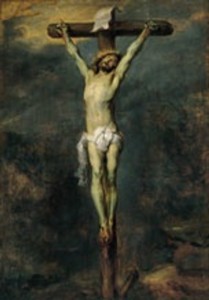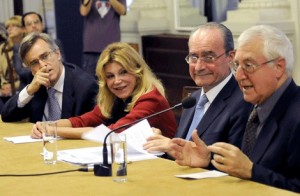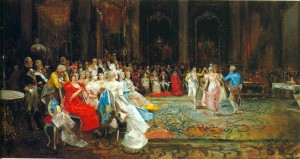Posts Tagged ‘Carmen Cervera’
Sunday, February 1st, 2015
| The lack of a fair distribution of assets in the world has reached a stage where the wealthiest 1% own more than the remaining 99% of the population, according to Credit Suisse. The Thyssens are a prime example of how a fortune, created through the dilligence of a few founding fathers and generations of their plants’ workforce, has multiplied exponentially through the use of financial instruments, multiple citizenships, political lobbying, press manipulation and, most of all, tax avoidance. It was the last great Thyssen himself, Hans Heinrich („Heini“) Thyssen-Bornemisza, who told us: „I am a tax evader by profession. If you wanted to be correct, I should be in jail“. Villa Favorita in Lugano, Ticino, Switzerland, the closest the Thyssen-Bornemiszas ever got to a family seat, has been the symbol of their often rapacious attitude – hidden behind the veneer of their famous art collection – which has until recently gone unquestioned, accepted and even admired by the wider public.
Even before the First World War, Heini`s grandfather August, whose power base were the German steel mills and coal fields of the Ruhr, created a family bank in Rotterdam, the Bank voor Handel en Scheepvaart (BVHS), as an offshore bank for the Thyssen industrial empire. Heini’s father Heinrich, who had gained Hungarian nationality and a contrived aristocratic status through marriage, settled in Holland, took charge of the bank and fended off the post-war allied reparation claims, as well as the spiralling early 1920s hyperinflation. His Dutch lawyers created further financial instruments such as Rotterdamsch Trustees Kantoor and Holland American Investment (respectively Trading) Corporations. This situation later allowed Heini to consequently deny the family`s German connections while they continued well into the 1980s to draw their profits from the country.
The Thyssens were very well connected on the highest political level. They hosted Adolf Hitler several times at their residences in Holland and Germany during the Weimar Republic and, amongst other contributions, made a loan of 350,000 Reichsmark through BVHS to finance the Brown House in Munich. After August’s death in 1926, and on the advice of Heinrich`s social and financial mentor Eduard von der Heydt, the Thyssens began to orientate themselves towards Switzerland. Heinrich started buying works of art to reinforce his „gentlemanly“ image but mainly, according to Heini, „as an investment and a way of moving money“. The 530 paintings he acquired between 1928 and 1938, though of questionable quality and provenance in many cases, and earning negative reviews when the first 428 were exhibited as „Schloss Rohoncz Collection“ in Munich in 1930, laid the foundation of the Thyssen-Bornemisza Collection now housed in Spain.
In 1926 and 1931, in the Swiss canton of Schwyz, Heinrich`s advisors created the Kaszony and Rohoncz Collection Family Foundations to hold and protect his inherited corporate assets and his art purchases respectively. Then, in 1932, he purchased 50,000 m² of Lake Lugano shoreline, comprising sub-tropical gardens and 12 buildings, a plot which had once been a whole quarter of noble villas, the most important being Villa Favorita. As Heinrich had bought the main residence complete with all furnishings in order to immerse himself in the style of the former princely owner, Leopold of Prussia, from 1936 to 1940 he had another building erected to house his art. But the exact logistics of the transfer of the paintings from their various points of purchase into Switzerland has remained shrouded in secrecy (its move out of Switzerland to Madrid half a century later was almost celebratory by comparison!).
In 1937, Heinrich’s Lugano lawyer Roberto van Aken, achieved a most favourable tax deal for his client with the Ticino authorities, as well as a Swiss foreigner’s passport, on the understanding that the collection be opened to the public. But while that same year his curator Rudolf Heinemann produced the first Lugano-based catalogue, the collection remained closed. Presumably neither side thought it wise to draw attention to the fact that this German tycoon was sheltering in Switzerland as his businesses supported Hitler’s genocidal war of aggression and exploited industrial slave labour – even though Helvetia profited from coal imports out of Heinrich’s Walsum mine through the Swiss Bank Corporation in Zurich. His German managers regularly visited him there, including the director of the August Thyssen Bank in Berlin, which organised funds for the world-wide German counter-espionage through Switzerland.
After 1945, this mutually beneficial Swiss safehaven arrangement guaranteed that Heinrich, who was initially named on the list of war criminals to be judged at the Nuremberg war crimes trials, entirely escaped allied retribution. He died at Villa Favorita in 1947, untouched by public controversy, though ravaged by his long-standing, advanced alcoholism. The public myth of the Thyssen-Bornemiszas’ untainted background could now fully develop.
His main heir Heini sorted out the vast inheritance and negotiated a new tax deal with the Swiss authorities by promising in 1948 to open the collection to the public. And so, Heini Thyssen, who had only ever possessed questionable Hungarian identity papers extended him by his step-father, Janos Wettstein, from the Hungarian embassies in The Hague and Berne, in 1950, after several attempts and with American assistance, gained full Swiss citizenship. Having become a founding member of the jet set and polished his image with the help of his British, third wife Fiona, in the early 1960s Heini turned to buying art to distance himself from the shadows of the family history. Through Eric Pfaff, an international trust lawyer, working out of offices in Luxembourg and the Isle of Man, he discovered Bermuda and had his first financial instruments created there, while many of his art purchases were made tax-efficiently through Liechtenstein-based instruments such as Art Council Establishment and Internationale Finanz- und Kunsthandel AG.
Then, in the mid-1970s, the first light breeze of change started wafting in as the Ticino authorities introduced more rigorous tax laws. But far from agreeing a compromise, Heini Thyssen responded by moving his official residence first to Monaco and later on to the United Kingdom. When he also threatened to close the gallery at Villa Favorita – by then one of the town’s and canton’s main tourist attractions – his Lugano lawyer, Dr Franco Masoni, managed to push through an extension of his client’s advantageous Swiss tax deal. Clearly it was in Heini’s power to pressurise the city fathers by inviting them to „consider the detrimental effect [this closure would have] on suppliers and employees“ and adding with sarcastic irony that he felt sure his „leaving the canton could be achieved without any publicity“…
Despite the continuous Swiss incubation of the fortune of Heini Thyssen-Bornemisza, who, in his 60s, by now had three ex-wives and four children, it was in Bermuda, under British law, that his advisors created, in 1983, two family trusts to protect his Thyssen Bornemisza Group (TBG) and his collection of paintings and artefacts from possible feuds over inheritance. The latter had by now trippled in size to over 1,500 works of art and its value was being promoted through auction houses, international travelling exhibitions and a lavish, Sotheby’s-promoted „catalogisation“ programme.
Shortly after his final marriage in 1985, in England, to the Spanish fire-cracker Carmen Cervera (who, it is thought, may already have enjoyed Swiss citizenship as a result of her 1960s marriage to Lex Barker), she too began, with Thyssen money, to buy art and, immediately, instruments, such as Nautilus Trustees Limited in the south-Pacific Cook Islands, were created for her use. It was not least at her instigation, in the early 1990s, that Heini Thyssen sold half his collection to Spain for 350 million dollars (plus a similar cost in housing and complex administration fees) and divided the net proceeds, as well as the other half of the collection between his heirs, through further, tax-free Bermudan sub-trusts. Now Carmen, with Heini’s help, could turn to creating and advertising her own Carmen Thyssen-Bornemisza Collection, thus spinning the money machine ad infinitum, while simultaneously creating a new, higher-quality personal image for herself.
Considering the depth of gratitude the Thyssens should have felt towards Switzerland for shielding them from revelations of Nazi collaboration and profiteering, this end to the Villa Favorita public gallery was more than ignominious. Heini topped his arrogant attitude by denying the generous offer that the Swiss had actually made him, in 1986, for keeping his collection in Lugano. His daughter Francesca continued to keep the gallery alive for a while with a few exhibitions, but some fifteen years ago it closed its doors for the last time. It is difficult to understand, apart from their greed, why the Thyssens did not have the grace to leave an endowment of a small „starter“ selection of paintings, plus the villa and grounds as a gift to the town. Considering the size of their fortune, they could easily have done so (and one day it might turn out that it would have been a wise thing to have done). But presumably, having achieved an advantageous tax deal in Spain, based on their collection, such a gift would have caused…….. a tax problem!? It was Carmen Thyssen-Bornemisza’s charming lawyer Jaime Rotondo, who in 2013 confirmed to the Spanish press outlet El Confidencial/(in collaboration with the Consorcio Internacional de Periodistas de Investigacion), in a somewhat questionable quote, that „the contracts of technical and cultural assistance she has signed with Spain [for the cession of over 700 paintings of her private collection to various museums means that Carmen Thyssen-Bornemisza can live in Spain all the time she wants without having to pay tax on her patrimony there]“.
In 2002, Heini Thyssen died and his widow Carmen inherited his 60 million dollar TBG dividend shortfall and a 132 million dollar share in his private estate, also several houses including the „Dynasty-que“ seat of Villa Favorita. When a year later she submitted to the Lugano building authorities a pre-project for the erection of four modern villas on its grounds, Swiss alarm bells started ringing. The Neue Zürcher Zeitung urged the authorities to „save this Swiss national cultural treasure“ and added that the Swiss Homeland Security Authority (Heimatschutz) had asked the communal, cantonal and federal authorities to act. Even a purchase by all three levels jointly was suggested. But while the paper went to great lengths to accuse officials of „stubborn desinterest“, it failed to mention the asking price, which was only revealed a decade later as being over 100 million Swiss Francs.
Then, in 2004, Swiss Info reported that cantonal levels were finally awakening from their „lethargy“ and negotiating with Tita Thyssen over Villa Favorita. The mayor of Lugano said that the lakeside area was placed under the protection of the Ticino cantonal commission of cultural assets and the Swiss federal commission for the protection of historical monuments and landscapes. Tita had renounced building on this area in return for a permit to build behind the gallery. Suddenly, town and canton were in a great hurry to achieve a deal. But still the canton did not wish to make any gifts to Tita, who, a decade ago, was said to have left the place „slamming the door with her collection under her arm“, while Pascal Couchepin, Swiss Minister of the Interior, was quoted as saying he doubted a sale to a private entity could be achieved. A wealthy Lugano municipal councillor then put one million Swiss Francs on the table to help the commune and canton enter negotiations.
While in 2010 it became known that Tita Thyssen had sold the last building plot of the grounds for 30 million Euros for the completion of eight Herzog & Meuron-designed luxury apartments by early 2015, negotiations for the sale of the main estate went quiet again. During that time, on the back-drop of a global financial crisis leaving her homeland Spain with a heavy debt burden and big (especially youth) unemployment rate, Tita adopted two surrogate children in California, her son Borja married and had four children and the two started mud-slinging very publicly over inheritance issues. In 2013, it was reported that a court judgment in Bermuda had revealed one of the trusts, which Borja has a 35% entitlement in, alone to be worth 1 billion Swiss Francs. But despite the crisis, the Spanish media at first still treated scenes such as CCTV pictures of Borja breaking into Tita`s office at La Moraleja, Madrid, to gain financial information, or Tita’s very public insistence on paternity testing for Borja’s children as fun entertainment. Later the mood began to change and the Spanish press slowly dropped its tolerant approach, particularly when Offshore-Leaks (via SonntagsZeitung, Spiegel Online, Huffington Post and others) publicised the extent of Carmen Thyssen’s art handling tax avoidance schemes and King Juan Carlos abdicated amidst allegations of widespread corruption amongst the Spanish elite. Suddenly her turning up for board meetings at the Madrid museum in her Rolls Royce Phantom (something her late husband would never have had the bad taste to have done) was said to „leave employees and visitors open-mouthed“.
By 2012, while the Swiss business magazine Bilanz was still ranking her as 7th richest woman in Switzerland, in Spain Tita was claiming on a somewhat theatrical level, via Vanitatis, to be going through her own liquidity crisis, which she said was caused by „800 million Euros worth [a non-binding valuation by Sotheby’s] of art loaned free of charge by myself to the state of Spain for 13 years“. She could hardly hide her frustration at the Spanish still not having bought her paintings from her, as they had once done with her husband’s collection. But with the precarious state of the monarchy adding to the economic crisis, she should perhaps have been grateful that they did not hand her collection back, for her to fund its maintenance, insurance, exhibition etc. Carmen Thyssen was left with no option but to sell a Constable (The Lock) – apparently through Omicron Collections Limited in the Cayman Islands – allegedly for 20 million pounds sterling (doubling the purchase price of a suspiciously high 10 million pounds in 1990) and further humiliated in the summer of 2014 when the Spanish tax authorities carried out a very public raid on her yacht “Mata Mua” in Ibiza, while she was on board (as reported by El Mundo). In her immediate rage she threatened to leave Spain and move back to Villa Favorita with her two adopted girls in tow. Not the first time she had issued such a warning.
So the news in December 2014 that Tita Thyssen has sold Villa Favorita to the Italian cheese-making family Invernizzi, for 65 million Euros, was understandably picked up with huge interest by the Spanish media. The 28 days in which Heini`s children had the right to match the sale price and retain the villa in the family have elapsed, and the sale is now final. One presumes Tita will be paying a little parting gift of tax on this deal in Switzerland, regardless of which trust or foundation the ownership of the villa is held in, as she waves good-bye to the country and brings to a close 83 years of a colourful relationship between the Thyssen-Bornemisza family and Ticino. It will be interesting to see how the Swiss will treat their memory of this family now that they have no reason to remain diplomatic, and equally so to see how the Spanish will treat Carmen Thyssen as she can no longer threaten them with a „cultural exodus in reverse“. There is one thing that could be almost guaranteed: that the opportunity once open to Heini Thyssen to play off one country against another, in their eagerness to host his fortune, will not be inherited by his successors.
p.s.: At our time of going to press, the Spanish press outlet Economia Digital reveals that Carmen Thyssen has this week bought two properties, for herself and her son Borja, in Andorra, for a total of 10 million Euros and comments: “Tita Cervera has Swiss nationality and since her youth her fiscal residence has been there. But for the last 20 years she has been a habitual resident of the Principality of Andorra. Sources knowledgeable about the aristocrat`s movements have signalled to this paper that she would be finalising a change in her tributary situation according to the double taxation agreements which Andorra holds with different countries and that it will permit her to also transfer her fiscal residence to the country where she actually lives.”
With the “99%” of the population of Spain increasingly taking to the streets to complain about the austerity policies, one wonders how much longer these shenanigans of the residual “1%” will last. |
|
 " Crocodile Tears ". (Carmen Cervera aka Tita Thyssen-Bornemisza, photo: El Confidencial - Vanitatis, Spain) |
Tags: 1920s hyperinflation, Adolf Hitler, Alcoholism, allied reparation claims, allied retribution, Andorra, art collection, Art Council Establishment, August Thyssen, August Thyssen Bank, Bank voor Handel en Scheepvaart, Berlin, Bermuda, Berne, Bilanz, Borja Thyssen-Bornemisza, Brown House Munich, California, Carmen Cervera, Carmen Thyssen-Bornemisza Collection, Cayman Islands, CCTV, coal mine, Consorcio Internacional de Periodistas de Investigacion, contrived aristocratic status, Cook Islands, Credit Suisse, double taxation agreement, Dr Franco Masoni, Dutch lawyers, Economia Digital, Eduard von der Heydt, El Confidencial, El Mundo, Eric Pfaff, fair distribution of assets, financial instruments, Fiona Campbell-Walter, Fiona Thyssen-Bornemisza, First World War, fiscal residence, Francesca Thyssen-Bornemisza, German counter-espionage, Germany, global financial crisis, habitual resident, Hans Heinrich Thyssen-Bornemisza, Heimatschutz, Heini Thyssen, Heinrich Thyssen-Bornemisza, Helvetia, Herzog & de Meuron, Holland, Holland American Investment Corporation, Holland American Trading Corporation, Huffington Post, Hungarian embassies, Hungarian nationality, Ibiza, industrial slave labour, inheritance, Internationale Finanz- und Kunsthandel AG, Invernizzi Family, Isle of Man, Jaime Rotondo, Janos Wettstein, jet set, John Constable, Kaszony Family Foundation, King Juan Carlos, La Moraleja, Leopold of Prussia, Lex Barker, Liechtenstein, list of war criminals, Lugano, Luxembourg, Monaco, multiple citizenships, Nautilus Trustees Limited, Nazi collaboration, Nazi profiteering, Neue Zürcher Zeitung, Nuremberg war crimes trials, offshore bank, Offshore-Leaks, Omicron Collections Limited, Pascal Couchepin, political lobbying, press manipulation, Principality of Andorra, questionable Hungarian identity papers, Roberto van Aken, Rohoncz Collection Family Foundation, Rolls Royce Phantom, Vanitatis, Yacht "Mata Mua"
Posted in The Thyssen Art Macabre, Thyssen Art, Thyssen Corporate, Thyssen Family Comments Off on The Times They Are A Changin (The Sale of Villa Favorita, Lugano – Part 1), by Caroline D Schmitz
Sunday, December 14th, 2014
| When I left Germany to live in England in 1992, my fatherland was only just beginning to get over the end of the Cold War, during which the Aufarbeitung of the Nazi era had been put on hold. In England, I got the amazing opportunity to work with David Litchfield on a biography of the Thyssen family which took us 14 years to complete and publish in England, Spain and Germany.
Now I am back in Germany and am delighted to see that a new wind is blowing as far as the renewed Aufarbeitung is concerned. But still it meets with opposition from those scrutinised. And yet, the time really is over-ripe for the descendants of those once in power to come clean and say „yes, what happened was terrible, and our families are admitting exactly what important role they played in it, and we are sorry“.
Instead, the Thyssen family in particular is still spending vast sums to produce sanitised versions of their history and this is particularly hurtful for me as a German whose family members were soldiers in Hitler`s war, who died or were maimed and never ever received any support whatsoever to cope with their horrific wartime experiences. This tragedy has had an overarching and enduring negative effect on German society. And this is why I am so angry with the way the Thyssens are behaving.
Heini Thyssen`s widow Carmen Cervera this year brought out his „memoirs“ in Spain, which is mostly theatrical nonsense but has a few unintended, highly interesting pieces of information, which we will present on this website in the new year. In particular, we will contrast her „effort“ with the other big Thyssen Whitewash Project that has seen the first fruits ripen in 2014.
As our manuscript was circulating in 2006, Heini`s son Georg Thyssen set up the „Thyssen Industrial History Foundation“ and later teamed up with the Fritz Thyssen Foundation and the ThyssenKrupp Archives under Manfred Rasch. They commissioned more than a dozen German academics under Margit Szöllösi-Janze, Günther Schulz and Hans Günter Hockerts to write a series of books on the Thyssens in the 20th century. So far, two volumes have appeared: „The United Steelworks under National Socialism“ by Alexander Donges and „Slave Labour at Thyssen“ by Thomas Urban. A third volume, “The Thyssens as Art Collectors” by Johannes Gramlich, is set to appear in March 2015 and some five more volumes thereafter.
Although these books do contain a number of admissions, the overall theme is still a denial of any wrong-doing on the side of the Thyssens. The smoke-and-mirror style convolutedness of the project`s mission statement can be seen from the summary of a conference held at the Berlin-Brandenburg Academy of Sciences in June 2014.
Based on our research and in the interest of historical truth, we will in the coming months and years on this website provide our readers with a detailed critical analysis of this Thyssen-financed „Aufarbeitung“. |
|
 Freiburg im Breisgau following a British bombing raid, November 1944 |
Tags: Adolf Hitler, Alexander Donges, Aufarbeitung, Berlin-Brandenburg Academy of Sciences, Carmen Cervera, Fritz Thyssen Foundation, Georg Thyssen, Günther Schulz, Hans Günter Hockerts, Heini Thyssen, Johannes Gramlich, Manfred Rasch, Margit Szöllösi-Janze, national socialism, slave labour, slave labour at Thyssen, The Thyssens in the 20th century, Thomas Urban, Thyssen Industrial History Foundation, ThyssenKrupp, United Steelworks, United Steelworks under National Socialism
Posted in The Thyssen Art Macabre, Thyssen Art, Thyssen Corporate, Thyssen Family Comments Off on Why I am angry with the Thyssens (by Caroline D Schmitz)
Sunday, December 14th, 2014
| Als ich 1992 Deutschland verließ und nach England zog hatte mein Vaterland gerade erst begonnen, den Kalten Krieg, während dessen die Aufarbeitung der Nazi Vergangenheit zum Erliegen kam, hinter sich zu lassen. In England hatte ich die unfassbare Gelegenheit mit David Litchfield an einer Biographie der Thyssen Familie zu arbeiten, für deren Vervollständigung und Publikation in England, Spanien und Deutschland wir 14 Jahre benötigten.
Jetzt bin ich zurück in Deutschland und freue mich zu sehen, dass ein neuer Wind in Sachen Aufarbeitung weht. Aber dem stehen die Hinterfragten teils immer noch mit erheblichem Widerstand entgegen. Dabei ist die Zeit nunmehr überreif für die Abkömmlinge derer, die damals in verantwortlichen Positionen waren, zu sagen „Ja, was passierte war schrecklich, und unsere Familien geben zu, was genau ihre Rolle dabei war und wir bekennen, dass es uns leid tut“.
Statt dessen geben speziell die Thyssens immer noch große Summen aus, um geklitterte Versionen ihrer Geschichte zu produzieren. Das ist besonders schmerzhaft für Leute wie mich, da meine Familienmitglieder Soldaten in Hitler`s Krieg waren, getötet wurden oder verletzt, und sie zu keinem Zeitpunkt auch nur die geringste Unterstützung erhielten, um mit ihren höchst traumatischen Kriegserlebnissen zu Rande zu kommen. Das ist eine Tragödie, die einen überwältigenden Langzeiteffekt auf die deutsche Gesellschaft hat. Und darum ärgere ich mich so über das Verhalten der Thyssens.
Heini Thyssen`s Witwe, Carmen Cervera, hat dieses Jahr in Spanien seine „Memoiren“ veröffentlicht. Das Meiste davon ist theatralischer Unfug, aber das Buch enthält auch einige, unbeabsichtigte interessante Informationen, die wir im neuen Jahr auf dieser Webseite vorstellen werden. Besonders konstrastieren werden wir dieses „Werk“ mit einem anderen, größeren Thyssen Weisswasch-Projekt, welches 2014 die ersten Früchte getragen hat.
Als unser Manuskript 2006 zirkulierte gründete Heini`s Sohn Georg Thyssen die „Stiftung zur Industriegeschichte Thyssen“ und schloss sich später mit der Fritz Thyssen Stiftung und dem ThyssenKrupp Archiv unter Manfred Rasch zusammen. Sie beauftragten über ein Dutzend Akademiker unter der Leitung von Margit Szöllösi-Janze, Günther Schulz und Hans Günter Hockerts, um eine Reihe von Büchern über „Die Thyssens im 20. Jahrhundert“ zu schreiben. Bisher sind zwei Bände veröffentlicht worden: „Die Vereinigte Stahlwerke AG im Nationalsozialismus“ von Alexander Donges und „Zwangsarbeit bei Thyssen“ von Thomas Urban. Ein dritter Band, “Die Thyssens als Kunstsammler” von Johannes Gramlich, soll im März 2015 erscheinen und danach mindestens fünf weitere Bände.
Obwohl diese Bücher in der Tat einige Eingeständnisse enthalten, so ist der überwiegende Tenor jedoch, dass eine direkte Verantwortung der Thyssens weiterhin nicht akzeptiert wird. Die verschleiernden Verschachtelungen der Missionsaussage können der Zusammenfassung einer Tagung entnommen werden, die zu diesem Projekt im Juni 2014 in der Berlin-Brandenburgischen Akademie der Wissenschaften stattfand.
In den kommenden Monaten und Jahren werden wir, basierend auf unseren Forschungen und im Interesse der historischen Wahrheitsfindung, unseren Lesern auf dieser Webseite eine detaillierte, kritische Analyse dieser Thyssen-finanzierten „Aufarbeitung“ zur Verfügung stellen. |
|
 Freiburg im Breisgau nach einem britischen Bombenangriff, November 1944 |
Tags: Adolf Hitler, Alexander Donges, Aufarbeitung, Berlin-Brandenburgische Akademie der Wissenschaften, Carmen Cervera, Die Thyssens im 20. Jahrhundert, Fritz Thyssen Stiftung, Georg Thyssen, Günther Schulz, Hans Günter Hockerts, Heini Thyssen, Johannes Gramlich, Manfred Rasch, Margit Szöllösi-Janze, Nationalsozialismus, Stiftung zur Industriegeschichte Thyssen, Thomas Urban, ThyssenKrupp, Vereinigte Stahlwerke AG, Vereinigte Stahlwerke AG im Nationalsozialismus, Zwangsarbeit, Zwangsarbeit bei Thyssen
Posted in The Thyssen Art Macabre, Thyssen Art, Thyssen Corporate, Thyssen Family Comments Off on Warum ich mich über die Thyssens ärgere (von Caroline D Schmitz)
Sunday, March 28th, 2010
| Interview with Sara Olivo for Epoca Magazine (Gaceta de Negocios) 12 March 2010.
EM: Do you think that Carmen Cervera and the Spanish State will come to an agreement for the Carmen Thyssen-Bornemisza Collection to remain in Spain?
DL: I hope not. The Spanish state does not need her pictures. And Carmen Cervera should not be asking the Spanish state for any payment. The Spanish state cannot afford it and the Madrid museum already loses money every year. So why pay more money to a wealthy Thyssen in order to lose even more money for the state? For the life of me I cannot think of a reason why Spain wants Carmen Thyssen’s third-rate pictures, when it already has too many first-rate pictures in other museums.
EM: What are the main difficulties faced by Tita to reach a satisfactory agreement?
DL: The main problems are her greed and Spain’s bad financial situation. She is trying to repeat the deal that her husband Heini made nearly 20 years ago. But she does not have his skill or knowledge. You did a terrible deal with Heini Thyssen. Even some of your own experts expressed scepticism about the wisdom of Spain buying his collection in 1993, for instance Eduard Castellet, President of the Fundacion Miro. So why would you want to do another, even more terrible deal?
EM: She says that she has offers from some museums in the USA and Europe. Can this be true?
DL: No, I don’t think that’s true. If she did, why would she not name them and say what they are offering her?
EM: She says she has as much money as people think…..Is it true?
DL: Her worth is never going to be what she says it is. I’m not sure she would even know herself. If she can claim that her pictures are worth €700 million, then of course she can claim to be a billionairess. But I believe that all of that is totally and completely exaggerated. Anyway, what does it matter how much money she has? She is taking money from Spain, not giving it.
EM: Is the Thyssen Collection overrated? Tita says it is worth €700 million.
DL: The Thyssen-Bornemisza Collection (i.e. Heini’s collection sold to Spain in 1993) is worthless, because it cannot be sold and requires constant taxpayers’ support to be housed and exhibited. As far as the Carmen Thyssen-Bornemisza Collection is concerned, as Carmen Cervera never says exactly what her collection comprises (240 pictures? 900 pictures? 3000 pictures?), it is impossible to value it. Therefore, what she is saying about its value is of no consequence. It is interesting, for instance, that the Spanish state seems to be insuring 655 of her pictures, when officially she is only exhibiting 240 at the Madrid museum:
http://vlex.com/vid/prestadas-coleccion-thyssen-bornemisza-15449009
EM: Can the negotiations affect the dispute between Tita and Borja and visa versa?
DL: Negotiations for what? She never says what she is negotiating. She constantly changes the number and nature of the pictures she wants Spain to rent from her. In Malaga, she is talking about a catalogue of 200 pictures, which only the conservative mayor has ever seen (not even the left-wing opposition in the town council has had the honour). The deal in Sant Feliu de Guixols is even more obscure, and yet she is talking about a ‘Thyssen museum network’ between the three locations. In the meantime, I calculate that Spain has already spent a total of around €100 milllion (!) to build facilities in Madrid, Malaga and Sant Feliu de Guixols to house parts of the Carmen Thyssen-Bornemisza Collection. If she is negotiating about pictures which are part of her son Borja Thyssen’s inheritance rights, then obviously he could challenge any deal.
EM: Do you think that being such a populist politician, Prime Minister Zapatero has a real interest in the collection with such a financial crisis as we currently have in Spain?
DL: I don’t understand why anyone, regardless of their political beliefs, would want to pay for pictures, some of which the Spanish state has already rejected before and others which were purchased from money previously paid to the Thyssens by the Spanish tax payer. It would be a bit like paying for the same thing twice!
EM: Tita said that the topic of her private collection is independent of the negotiations on the future of the Thyssen Museum. Do you think this is true?
DL: Carmen Cervera’s pictures housed in the Madrid museum since 2004 were not part of the original agreement with Heini, for which Spain paid $350 million in 1993 (according to my figures it was actually closer to $600 million if you include the real estate, architectural costs, insurance, lawyers fees, administration, etc,. etc.). Heini Thyssen did, however, manage to get a foot in the door for his wife by signing a separate agreement to loan an additional 70 pictures to the Madrid museum which remained in the ownership of him and Tita. This seems to be the basis of what she is trying to negotiate for Madrid now. This leads to an interesting point, which is that very few Spanish people (if any) have ever seen the original agreement. I have seen it, which is why I know that Spain made such a terrible deal.
I believe, that as a Spanish tax payer, you have the right to demand concrete information about all of this. At the moment, it is still all shrouded in a veil of smoke and mirrors. I can think of no reason why anyone would even consider acquiring her pictures, unless they are being paid some form of commission for doing so. On a personal level, I would also like to say that in my eyes, Carmen Cervera’s vulgarity and lack of taste actually damages Spain’s cultural image internationally. One more thing, which is very important: neither Tita nor Borja can do anything to affect the status of the original paintings bought by Spain from Heini Thyssen. Some reports make it sound like she could take Heini Thyssen’s pictures out of the Madrid museum as well. She cannot! |
 More, More, More, More, More, More, More, More, More, More, More, More, More, More, More, More, More, More, More, More, More, More, More, More, More, More, More, More, More, More, More, More, More, More, More, More, Mas, Mas, Mas, Mas, Mas, Mas, Mas, Mas, Mas, Mas, Mas, Mas, Mas, Mas, Mas, Mas, Mas, Mas, Mas, Mas, Mas, Mas, Mas, Mas, Mas, Mas, Mas, Mas, Mas, Mas, Mas, Mas, Mas, Mas, Mas, Mas, Mas, Mas, Mas, Mas, Mas, Mas, Mas, Mas, Mehr, Mehr, Mehr, Mehr, Mehr, Mehr, Mehr, Mehr, Mehr, Mehr, Mehr, Mehr, Mehr, Mehr, Mehr, Mehr, Mehr, Mehr, Mehr, Mehr, Mehr, Mehr, Mehr, Mehr, Mehr, Mehr, Mehr, Mehr, Mehr, Mehr, Mehr, Mehr, Mehr, Mehr, Mehr, Mehr... |
Tags: Borja Thyssen, Carmen Cervera, Carmen Thyssen-Bornemisza Collection, Eduard Castellet, Epoca Magazine, Fundacion Miro, Gaceta de Negocios, Heini Thyssen, Madrid, Malaga, Sant Feliu de Guixols, Sara Olivo, Spain, Thyssen Museum, Thyssen-Bornemisza Collection
Posted in The Thyssen Art Macabre, Thyssen Art Comments Off on Will Spain Give The Thyssens A Second Gold Hoard?
Sunday, January 10th, 2010
| At last! Spain begins to question the quality of the Thyssen-Bornemisza Collection, what the taxpayers might have got for their money and the wisdom of paying yet more money for ‘Tita’s Collection’. These were all things we have been publicly questioning for the last three years. So why has it taken so long? Without wishing to sound cynical, could it be a result of the credit crunch? While Spain was flooded with Euros, nobody wanted to see the King naked.
Today’s critic, Dr Juan Jose Junquera, is a Professor of Art History at Complutense University in Madrid, and as such could hardly claim to be a stranger to the collection. Perhaps the Thyssen-Bornemisza Collection Foundation Board, particularly Sir Norman Rosenthal, will now be obliged to make a comment, though with Rosenthal’s wife still working at the Prado, he could of course be accused of a conflict of interest.
The following is a translation of the Spanish original from today’s ABC newspaper.
No wonder Tita is busy preparing Villa Favorita in Lugano for re-occupancy. This feature looks to me like the Culture Ministry’s way of say ‘No’ to any further deals with Tita and if this one hits the buffers, Malaga looks ever less likely.
“After reading Carmen Cervera’s declarations in ABC on Sunday 3 January, I’ve had the following thoughts: I’m not doubting the generosity of her offer to loan the Thyssen Collection, but I’m asking myself of how much interest it actually is to the Spanish taxpayers. We still don’t know which paintings will stay in Spain once the current cession agreement concerning the collection of her late husband, Baron Thyssen-Bornemisza, ends, which was a question raised in its day by the then Director of the Prado, Professor Perez Sanchez, and to which there still hasn’t been a reply. In the meantime, the Prado lacks good quality Dutch paintings, such as Franz Hals, gaps which the Dutch Masters of the Thyssen Collection cannot fill. Is it really advisable to spend the few Euros that the Culture Minisry has available in order to rent a Gauguin escorted by paintings of somewhat dubious quality and authenticity on a background of nineteenth century artists whose works already gather dust in the storage rooms of both the Prado and provincial museums? Nobody doubts the commercial acumen of Baroness Thyssen; but what we mustn’t do is buy a lift for a bungalow without discussing the matter in public.”
http://www.abc.es/20100110/opinion-cartas/lectores-20100110.html
ABC Y SUS LECTORES, Domingo , 10-01-10
……..«La atenta lectura de las declaraciones de doña Carmen Cervera en ABC del domingo 3 de enero me sugiere unas reflexiones -dice JUAN JOSÉ JUNQUERA, catedrático de Historia del Arte de la Universidad Complutense-. No es que dude de la generosidad de su oferta de alquiler de la colección Thyssen, pero me pregunto hasta qué punto éste interesa a los contibuyentes españoles. Aún no sabemos cuáles son los cuadros que quedarán en España cuando acabe el convenio vigente de cesión de la colección de su difunto marido, el barón Thyssen-Bornemisza, pregunta que formuló en su día el que era director del Prado, profesor Pérez Sánchez y que aún no tiene respuesta. Mientras, el Prado carece de holandeses de calidad como Franz Hals, huecos que no cubren los maestros holandeses de la Colección Thyssen. ¿Realmente interesa gastar los poco euros de que dispone Cultura en alquilar un Gauguin escoltado por cuadros bien de dudosa calidad o autenticidad, bien de segundones decimonónicos cuyas obras decansan en los depósitos del Prado y de los museos de provincias? Nadie duda de las cualidades comerciales de la baronesa viuda Thyssen; lo que no debemos hacer es, sin discutirlo públicamente, comprar un ascensor para un chalet de planta baja……..». |
 One of Tita's ten 'Gauguins (?)', which could become the subject of her forthcoming 'cleansing' operation (see ABC newspaper on 03.01.2010).  "'The Crucifixion', attributed to a painter from the circle of Sir Anthony van Dyck, which Heini purchased from Sotheby's at the 1995 sale of the Bentinck-Thyssen Collection for only £17,000 and immediately re-attributed to the Master himself" (from: 'The Thyssen Art Macabre' / 'La Historia Secreta de los Thyssen') |
Tags: ABC newspaper, Anthony van Dyck, Bentinck-Thyssen Collection, Carmen Cervera, Credit Crunch, Culture Ministry, Franz Hals, Gauguin, Juan Jose Junquera, Lugano, Malaga, Perez Sanchez, Prado, Sir Norman Rosenthal, Sotheby's, Spain, Taxpayer, Thyssen-Bornemisza Collection, Thyssen-Bornemisza Collection Foundation Board, Universidad Complutense, Villa Favorita
Posted in The Thyssen Art Macabre, Thyssen Art Comments Off on Thyssen Art Elevator Hits Spanish Buffers
Tuesday, November 10th, 2009
| As the ravenous ThyssenArt Beast proceeded to eat its way through Malaga’s hot, sleepless nights, the Board of the Museo Carmen Thyssen-Bornemisza Foundation met for the very first time, presided over by ‘Our Precious Lady Carmen of The ChaChaCha’.
It seemed fitting for such a splendid occasion that it occurred in the town’s ‘Great Hall of Smoke and Mirrors’, which glittered proudly for ‘Carmen The Accumulator’s’ reunion with Vice-Presidente Francisco de la Torre (conservative mayor of Malaga), councillors Miguel Briones, Mariluz Reguero and Pedro Moreno Brenes, Tomas Llorens (former director of the Museo Thyssen Madrid), Guillermo Solana (current director of the Museo Thyssen Madrid) and one Teresa Sauret Guerrero. Only the identity of the other three members of the eleven-strong MCTBF board remained shrouded in deepest mystery.
Now, for some time, the unruly Izquierda Unida and their friends had been the lone ‘voice in the wilderness’, most un-‘preciously’ questioning the wisdom of spending tens of millions of Euros of taxpayers’ money on refurbishing crumbling provincial palaces to create more Thyssen Museums, bearing in mind that the Thyssens’ ‘precious’ immortality had already been subsidised in the country’s capital for twenty years to the tune of some 500 million Euros.
The main concern was the question of how many and exactly which of ‘The Baroness’s’ 1000 paintings – valued by The Great Art Expert herself at 800 million very ‘precious’ Euros – would eventually be housed in the new great institution. The only words crossing Her Magnificence’s own rose-scented lips was that they would all be ‘very nice’ and ‘very…..precious’, a view shared whole-heartily by the other defenders of The ThyssenArt Beast, all of them interested parties in their own ‘precious’ ways.
And so, as Mayor de la Torre opened the day’s proceedings, it looked like any remaining dissent could finally be quelled once and for all, when the solemn declaration was made that there would be not one but…..EIGHT (!) collections at the Carmen Thyssen-Bornemisza Museum in Malaga, and that these would comprise ‘romantic landscapes’, ‘naturalist landscapes’, ‘naval paintings’, ‘old masters’, ‘pictures from between the centuries from Tradition to The Renovation’, ‘portraits of Andalucia and Spain’, ‘costumbrism’, and, finally…..: ‘PRECIOUSCISM’!
Unwaware that this was just a word created during a game of scrabble between Guillermo Skywalker and Anikin Rosenthal, the common folk at once began to cheer uncontrollably. Men threw their hats in the air and women frantically fanned their flushed cheeks, while everyone whooped and hollered in manic delight: ‘It’s a miracle! My God, a miracle! What a great Baroness she is, Our Lady ChaChaCha. She is so beautiful and so good to us! We are so utterly greateful to her! Long may she live! Long may she live!‘.
Indescribable scenes of sheer, ‘precious’ ecstasy ensued, the crowd chanting ‘Pre-cious! Pre-cious! Pre-cious! Pre-cious!’ until their voices grew hoarse.
Finally, The ThyssenArt Beast’s old Jedi Master, Yoda Llorens, managed to regain control over the hysterial mob and delivered his coup de grace: the museum’s Mission Statement. Apparently it was ‘the intention of the museographic contents of the new art centre’….‘to mould a picture of Spanish society, and of that of Andalusia in particular, beginning with the romantic period and stretching through to the begining of the 20th century’.
Here the breath of the common folk was held for some time as they struggled to grasp the true meaning of the Jedi Master’s wise words. Stunned silence pervaded the air, until, out of the blue, one lone voice of dissent, Al Panpan, spoke out: ‘This picture of Andalusia which you are planning to ‘mould’, is a manipulative and unreal picture which was constructed from afar and represents the starting point of all the problems that came crushing down on us in the 20th century. I propose that Carmen Cervera inaugurate her new little museum wearing flamenco flounces and that the mayor joins her dressed up as The Joker’.
Security pounced at once, bundled up the obviously insane lone critic and quickly ushered him off to an uncertain future, but dark clouds began to gather, as great thunder rolled and lightening flashed, threatening to shatter the multitude of ‘precious’ mirrors. Suddenly, the form of ‘Borja, The Great Mighty Heir’ filled the doorway, lit by a single shaft of ghostly light. Terror descended. The people shivered with fear. Pausing, ‘The Great Mighty Heir’, with his inimitable stutter (a sure sign of true aristocratic breeding) began to read out passages from Hola Magazine, that most ‘precious’ of avant-garde gazettes: ‘G-g-gggg Gggigive me my Dddddog, my Dodododgy Ggggg-Goya. This is my uneq- eq- eqqqqq, un-eq, my un-eqqqqquiqui-, my uneqqqqui-vocal right!’, he finally roared in his booming voice.
It was later said that at this exact, precious moment in time, The King, who was not present but many hundreds of miles away, felt a sharp pain in his side and began to fear the worst for his magnificent, ‘precious’ friend, Tita Thyssen, and lo he was grieved!!
Sensing The King’s grief in reverse telepathy, the people started shouting: ‘Go home, Great Mighty Heir! Sling it! Get a job! And don’t you dare touch OUR precious paintings! They are OUR precious paintings, do you understand??!!’
And with a last whimpering roll of thunder he was gone.
The Great Impressionables had spoken. And so it was that The Great Accumulator’s ‘precious’ paintings were saved for the Spanish nation forever. Or as long as the Four Amigos can keep reaching deep into the wallets of the precious people of Spain. |
 The Four Amigos: Guillermo 'Skywalker' Solana, 'Carmen The Accumulator', Francisco 'The Joker' de la Torre and Tomas 'Great Jedi Master Yoda' Llorens, addressing the people of Malaga on 21 October 2009  The Dodgy Goya.  Another Dodgy Painting: Allegedly a 'Santa Marina' by Francisco de Zurbaran. Soon to be housed at the Carmen Thyssen-Bornemisza Museum in Malaga?  The Lady Dances (Manuel Cabral Aguado Bejarano, 1889)  Dances At The Palace (Eugenio Lucas Villamil, 1894)
|
Tags: Carmen Cervera, Francisco de la Torre, Guillermo Solana, Hola Magazine, Izquierda Unida, Malaga, Mariluz Reguero, Miguel Briones, Museo Carmen Thyssen-Bornemisza, Pedro Moreno Briones, Preciosismo, Teresa Sauret Guerrero, The ThyssenArt Beast, Tita Thyssen, Tomas Llorens
Posted in The Thyssen Art Macabre, Thyssen Art Comments Off on Preciosismo: A Fairy Tale Of Modern Spain (by The Great Collaborator)
Tuesday, May 26th, 2009
| The fulfilment of the ambition of Heini Thyssen’s widow, Carmen Cervera, to see her own name in lights on a public museum – rumoured locations for which have so far included Madrid, Seville, Sant Feliu de Guixols and Malaga – continues to hang in the balance, as it has done, now, for some five years.
First political concerns about the plans for a Carmen Thyssen Bornemisza Museum in Malaga were raised in May 2008, when the professor of law at Malaga University and spokesperson for the United Left Party, Pedro Moreno Brenes, urged the local government to stop developing the new museum (for which € 25 million had already been budgeted) until a fully committed contract had been signed.
Then, on 31 March 2009, much was made of Carmen Thyssen and Malaga’s mayor, Francisco de la Torre, signing the papers to set up the foundation which is to manage the museum. Pictures were taken of ‘Tita’ laying the foundation stone.
While de la Torre had apparently been given three catalogues by the ‘Baroness’ from which 200 pictures would be chosen for the museum (on loan for 15 years), and it was claimed they were all “very attractive and interesting”, the opposition has so far failed in their attempts to gain access to an exact and definite list of the proposed works to be exhibited. Names of artists bandied about have included “Zurbaran, Zuloaga and Sorolla”.
On 19 April 2009, Moreno Brenes’s party presented a motion to the town council, critising the “notable legal insecurity” in the ongoing Thyssen negotiations, while adding that the budgeted costs for the Carmen Thyssen Bornemisza Museum of Malaga (to be opened at the end of 2010) had by now increased to € 38 million.
Today comes news that the main opposition party, the PSOE, which forms the national government of Spain, has joined the ranks of the critics of this project. Their spokesperson for the Malaga town government, Rafael Fuentes, has told Europa Press that Mayor de la Torre has “sacrificed the needs of ordinary citizens of Malaga in favour of pet projects of Barons and Earls” and that there is a marked “lack of transparency” in the Thyssen and other projects.
http://www.europapress.es/andalucia/noticia-psoe-critica-pp-ciudad-parada-no-haya-arrimado-hombro-lucha-contra-crisis-20090525152909.html
http://www.europapress.es/autonomias-00175/noticia-iu-insta-pp-conocer-obras-museo-thyssen-garantice-calidad-mismas-20090419112014.html
http://www.laopiniondemalaga.es/secciones/noticia.jsp?pRef=2008052100_2_181054__Malaga-pide-gastar-dinero-Thyssen-hasta-firmar-contrato |
|
 Tita Thyssen-Bornemisza cementing her future in Malaga (courtesy of Hola Magazine, 31 March 2009) |
Tags: Carmen Cervera, Carmen Thyssen Bornemisza Museum, Francisco de la Torre, Heini Thyssen, Hola Magazine, Malaga, Pedro Moreno Brenes, Rafael Fuentes, Sant Feliu de Guixols, Tita Thyssen
Posted in The Thyssen Art Macabre, Thyssen Art Comments Off on Tita Thyssen’s Proposed Malaga Gallery Questioned
|












